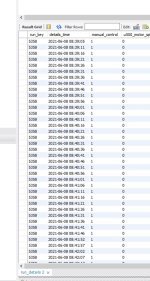lunenburger
Member
I have been searching for a way to insert a line into a MySql database once every five seconds.
I was using Advanced HMI and the timer tick function which worked perfect.
Now with the VbScript, i can get the data to insert, but it keeps looping and inserting continuously getting a duplicate primary key error.
So I have two questions:
Is there a function like timer tick that will send the insert function only once?
If I use a timer in the PLC or the second tag in Indusoft, how do I get the insert to only fire once?
thanks in advance....
I was using Advanced HMI and the timer tick function which worked perfect.
Now with the VbScript, i can get the data to insert, but it keeps looping and inserting continuously getting a duplicate primary key error.
So I have two questions:
Is there a function like timer tick that will send the insert function only once?
If I use a timer in the PLC or the second tag in Indusoft, how do I get the insert to only fire once?
thanks in advance....




